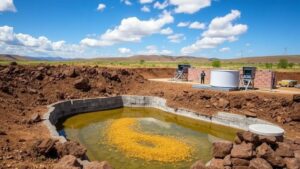Setting Up a Small-Scale Smelting Furnace for Precious Metal Recovery
Setting Up a Small-Scale Smelting Furnace for Precious Metal Recovery
The recovery of precious metals such as gold, silver, and platinum from various electronic waste and scrap materials has gained attention due to both economic viability and environmental sustainability. A small-scale smelting furnace can be instrumental in this endeavor. This article provides an in-depth look at setting up such a furnace, detailing the materials, processes, and safety considerations necessary for effective precious metal recovery.
Understanding Smelting
Smelting is a metallurgical process that involves the extraction of metals from their ores using heat and chemical reducing agents. In the context of precious metal recovery, smelting typically refers to the application of high temperatures to separate valuable metals from other materials.
A fundamental analogy to understand smelting is to compare it to brewing coffee. Just as coffee grounds are heated in water to extract flavor, ores are subjected to heat to extract metal. By controlling the temperature and adding flux materials, the desired metals separate from non-metallic components.
Materials Needed for a Small-Scale Smelting Furnace
Setting up a small-scale smelting furnace requires specific materials and tools. Here’s a list of essential components:
- Furnace: A small propane furnace or an electric induction furnace can be employed depending on budget and availability.
- Casting Mold: A mold is necessary for shaping the molten metal into ingots.
- Crucibles: High-temperature resistant crucibles are required to hold the material being melted.
- Fluxing Agents: Common fluxes include borax and soda ash, which help to separate impurities during smelting.
- Protective Gear: Safety equipment such as gloves, goggles, and heat-resistant clothing are crucial for safe operation.
Steps to Set Up the Smelting Process
Setting up for precious metal recovery involves several steps that require accuracy and attention to detail:
- 1. Gather Your Materials: Ensure all tools and materials are readily available and in good condition.
- 2. Prepare the Workspace: Choose a well-ventilated area away from flammable materials. An outdoor space is often ideal.
- 3. Set Up the Furnace: According to the manufacturers instructions, assemble your furnace, ensuring it is stable and correctly positioned.
- 4. Load the Crucible: Place the desired material and appropriate flux into the crucible.
- 5. Ignite the Furnace: Start your furnace, closely monitoring the temperature as it rises.
- 6. Pour the Molten Metal: Once the desired temperature is achieved, carefully pour the molten metal into the casting mold.
- 7. Allow to Cool: Let the metal cool and harden before removing it from the mold.
Safety Considerations
Safety must always be a priority during precious metal recovery. Workers should follow these essential guidelines:
- Work in a well-ventilated area: Fumes from smelting can be hazardous; proper ventilation can mitigate risks.
- Wear protective gear: Eye protection, gloves, and protective clothing are crucial to prevent burns or injuries.
- Keep a fire extinguisher nearby: Always have a means to extinguish fires in case of emergency.
Real-World Applications and Case Studies
A notable example of small-scale smelting can be seen in urban mining operations, where individuals recover precious metals from e-waste. Studies indicate that over 50 million tons of e-waste is generated annually, containing precious metals that are often discarded. Entrepreneurs engage in small-scale smelting to extract these metals, not only reducing waste but also generating income.
For example, an operation in the Philippines showcases success in recovering gold using homemade furnaces, demonstrating a practical approach to metal recovery that benefits the local economy and environment.
Actionable Takeaways
Setting up a small-scale smelting furnace for precious metal recovery can be a rewarding venture. To succeed, consider the following actionable takeaways:
- Conduct thorough research on the materials you plan to smelt.
- Follow safety protocols diligently to ensure a safe working environment.
- Consider the environmental impact and legal requirements pertinent to metal recovery in your region.
By meticulously planning and adhering to safety guidelines, individuals can effectively participate in the precious metals market through small-scale smelting, while contributing to sustainable practices in material recovery.


